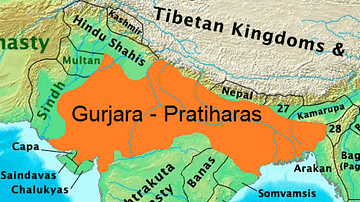Gurjar Pratihara Dynasty | Gurjar Pratihar Vansh Notes | History of Gurjara Pratihara Dynasty
[google-translator]
Mahipal – 914-43: –
-
He was the son of Mahendrapal I and became the ruler after Bhoj II.
-
Renowned scholar Rajasekhar Mahipal was also present in the court.
-
Rajasekhar has called Mahipal ‘Raghu Kul Mukutmani’ in ‘Prachanda Pandava’.
-
Even in the time of Mahipal I, the tripartite struggle of Kannoj continues. In this period, Rashtrakuta ruler Indra III invades Kannoj and destroys Kanoj.
-
Due to which the tripartite struggle ends, but after some time, Mahipal first regains Kannoz and reorganizes it.
-
It was during the time of Mahipal I that the arrival of Arabiatri Almasudi came to India (915).
-
Al-Masudi was the first to discuss the Indian monsoon.

Gurjar Pratihar Dynasty, Gurjar Pratihar Vansh
The first mention of the word Gurjar came from the ‘Aihole inscription’ of the Chalukya king Pulakesin II.
The word Pratihara means – Gatekeeper.
Gurjar Pratihar Vansh initially served as the gatekeeper of the Rashtrakuta rulers, for which the word Gurjar was used as a resident of the state “Gurjaraatra” (a border state of Rajasthan and Gujarat).
Chandrabardai mentions 26 branches of Pratiharas. Of which the oldest branch is ‘Mandore’, and the most powerful Bhinmal branch.
Chinese traveler Xuanzang has also mentioned Ku-Che-la country in the description of the journey of 72 countries. Whose capital is Pilomola / Bhilamala?
Contemporary historians have given the meaning of Ku-Che-La to the Jalore area and Pilomola meaning to Bhinmal.
The founder of the Pratihara dynasty was Harish Chandra Brahmin of Mandore in 600 AD, its two queens were the children born of Brahmin queen, Brahmin Pratihara and the children of Kshatriya queen Bhadra called Kshatriya Pratihara. Bhadra had four sons, of whom the third child was ‘Razzil’, Razzil’s grandson was ‘Nagabhatta I’.
Nagabhatta First: –
It was the first powerful ruler of the Gurjar Pratihar dynasty (Gurjar Pratihar Vansh), its court is called ‘Nagavalok’.
Nagabhatta I is said to be the symbol of the Pratihara of Rama, the war of Meghnath, the destroyer of Indra’s pride, Narayana.
Nagabhatta I had a conflict with the Arab invaders on the borders of Sindh province, in which he remains victorious.
After defeating the Arabs, he assumed the title of ‘Narayana and the destroyer of malchis’.
Nagabhatta I also had a conflict with the Pala rulers of Bengal, in which he was defeated.
Nagabhatta I, while expanding the empire, ruled Mandore, and made Ujjain / Avanti his second capital.
Nagabhatta I also has a conflict with the Rashtrakuta rulers in which he is defeated, Nagabhatta I played the role of Pratihara in the Hiranyagardhan Yagna performed at Ujjain by Rashtrakuta ruler Dantidurga.
After Nagabhatta I, his nephew Kakkuk becomes the ruler, and after this, his brother Devaraja becomes the ruler.

Vatsaraj 783-95: –
He was the son of Devaraja, who is said to be the actual founder of the Pratihara dynasty.
Vatsaraja held the titles of ‘Ran-Hastin’ and ‘Jaiwarah’.
Udyotan Suri, the author of Kuvalayamala, and Acharya Jinsen Suri, the creator of Harivanshpuran, were court scholars of Vatsaraja.
Tripartite Conflict: – During the reign of Vatsaraja, a tripartite struggle started with the Rashtrakuta rulers of Pal, Manyakhet of Bengal over the authority over Kannoz, which lasted one and a half-century (175 years).
Kannoj, being the main trading center at this time, was considered to be the principal center of the whole of India, who was the ruler of Kannoz, he was called the Chakravarti Emperor of India.
Kannoj was established by Harshavardhana as the capital, after Harshavardhana, Kannoj was ruled by the Nirbal dynasty Ayudha dynasty, two brothers of the Ayudha dynasty, Indrayudh and Chakrayudha were fighting for succession among themselves, due to which the three great powers of India were Gurjars. Pratihara, Pal, and Rashtrakuta wanted to take control over Kanoj and a tripartite struggle between them begins.
Struggle with the Palas: – The Vatsaraja empire is expanding, defeating the Pala ruler Dharmapala in the Ganges-Yamuna Doab, towards Kannoj but at the same time, Dharampal invites the Rashtrakuta ruler Dhruv I. Dhruva I had defeated Vatsaraja, due to which Vatsaraja has to take refuge in the desert.
Dhruva I had captured Kannoz by defeating the Pala ruler Dharmapala, to commemorate this victory, Dhruva I made ‘Ganga-Yamuna Doab his state emblem’.
But due to the rebellion in South India, Dhruva leaves Kannoj and at the same time, Dharampal gives protection to Chakrayudh and makes him the ruler of Kannoj.

Nagabhatta II – 795-833 AD: –
It was the successor of Vatsaraja, its court was also called ‘Nagavalok’,
Nagabhatta II is known as ‘Parambhattaraka Maharajadhiraj Parameshwara’
The tripartite struggle of Kannoj: – Nagabhatta II defeats Dharmapala and removes Chakrayudh and makes it his second capital, but at the same time Rashtrakuta ruler Govind III defeats Nagabhatta and takes control of Kannoj, but after some time Govind III is defeated in South India. One has to return at this time Nagabhatta II takes Kannoj back under his control.
Note: – Nagabhatta II took a living samadhi in 833 AD.
Rambhadra 833-36 AD: –
It was a weak son of Nagabhatta II, Rambhadra Pal leaves Kannoj without fighting the ruler Devpal without fighting, due to this incident Mihir Bhoja, son of Rambhadra, kills Rambhadra.
Mihirbhoja was the first ancestral ruler of the Pratihara dynasty.

Mihir Bhoj I – 836-85 AD: –
Mihirbhoja becomes the ruler by killing Rambhadra, Mihirbhoja was the most powerful ruler of the Pratihara dynasty and extended the most empire in the Pratihara dynasty.
In the Gwalior inscription Mihirbhoj’s title ‘Adivarah’ is mentioned.
Mihirbhoj also assumed the title of ‘Prabhas’.
During this period, silver and copper coins derive the title of ‘Srimadadivarah’.
During this period, the Arab traveler Suleman (851) arrives in India.
Suleman has called Mihirbhoja as ‘Barua’, calling it ‘enemy of Islam’, and calling India a country of infidels.
Kannoz’s Tripartite Conflict: – Mihirbhoja makes Kannoz his permanent capital by taking over.
Mihirbhoja is defeated by the Pala ruler Devpal, and also defeated by the Rashtrakuta ruler Krishna II in battle on the banks of the Godavari river, but he retains his authority over Kannoj.
In 885 AD, Mihirbhoj renounces the throne in favor of his son Mahenderpal I for pilgrimage for the purpose of religious work.
Mahendrapal I – 885-910 AD: –
Like Mihirbhoj, Mahendrapal I also continued the expansion of the empire and defeated the Palas, and ruled Bengal and Bihar.
The famous scholar Rajasekhar resided in the court of Mahendrapal.
Rajasekhar has called Mahendrapal ‘Raghu Kulchamani’.
It was Rajasekhar who conferred the titles of ‘Nirbhayaraj’ and ‘Nirbhay Narendra’.
Mahendrapal I assumed the title of Parambhagavata, Maharajadhiraja, Parambhattaraka, and Parmeshwar.
Major compositions of Rajashekhar: – Karpoormanjari, Kavmimamsa, Vidishalabhanjika, Harvilas, Bhuvanakosh, Balramayana, Bal Bharat, Prachanda Pandava etc.

Governor – 990-1019 AD: –
During this time, Mahmud Ghaznavi is attacked by Kannoj, which the governor is defeated by performing in a cowardly manner, the governor was killed by the Chandela ruler Vidyadhar after being defeated by Ghaznavi.
Trilochanpal – 1019-1027: –
-
Trilochanpal shifted his capital from Kanoj and established ‘Bari’.
-
During this period, Ghaznavi invades India again.

Yashpal: –
-
It was the last ruler of Pratihar dynasty (Gurjar Pratihar Vansh).
-
Who was the last great Hindu Emperor of Hindu India – Mahendrapal I (according to PN Pathak)
-
Who was the last Hindu Emperor of India – Prithviraj Chauhan III
-
Who is called the last Hindu emperor of India – Hemu
-
Who has been called the last great Hindu Emperor of India by Colonel Tod – Rana Sanga
-
Arab travelers have used the word ‘Algujar’ in place of Gurjara Pratihar and have called Gurjar as ‘Jurj’ and Raja as ‘Bora’.
-
Ghaznavi’s first attack on Kannoz was on 20 December 1018.

www.GKDuniya.in will update many more new jobs and study materials and exam updates, keep Visiting and share our post of Gkduniya.in, So more people will get this. This content and notes are not related to www.GKDuniya.in and if you have any objection over this post, content, links, and notes, you can mail us at gkduniyacomplaintbox@gmail.com
And you can follow and subscribe to other social platforms. All social site links in the subscribe tab and bottom of the page.
Important Links
Particulars Official Links |
Related Links |
You-tube |
GKDuniya9 |
|
|
GKDuniya.in, IndiaDigitalHub |
|
|
GKDuniya.in |
Another site visit |
Indiadigitalhub.com |





